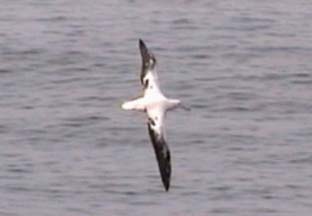
(Click on any image below for a larger version)
Sunday, January 21
Sunday dawned foggy and calm as we crossed the Drake Passage. The water was very flat and the ship made its best speed as we headed southward. Later in the morning, the ship sailed into the sunlight. The air temperature was in the forties. It was just about the best possible weather that can happen in that part of the world.
We were told that the ship had encountered waves 50 feet high while making the crossing the previous month. Some of the ship's windows had been stove in.
After cruising in the sun for a while, the ship reached another fog bank. In moments we were back under the overcast.
The first lecture of the day was a presentation by Don Wilson of the Smithsonian Institute about the marine mammals that we could expect to see in the Antarctic. He described the various species of seals and whales that frequent the southern ocean.
After Don Wilson's lecture I took my video camera on deck to shoot tape of the seabirds.
 A Wandering Albatross was soaring back and
forth behind the ship, making use of the air currents created by
the passage of the ship. It had a larger area of white on its
wings than the Wandering Albatross that we had seen on our
departure from the Beagle Channel indicating that it was an older
bird. A pod of Dusky Dolphins swam along with the ship for a
while, occasionally leaping clear of the water.
A Wandering Albatross was soaring back and
forth behind the ship, making use of the air currents created by
the passage of the ship. It had a larger area of white on its
wings than the Wandering Albatross that we had seen on our
departure from the Beagle Channel indicating that it was an older
bird. A pod of Dusky Dolphins swam along with the ship for a
while, occasionally leaping clear of the water.
Later in the afternoon, Dave Fletcher, who had been with the British Antarctic Expedition, made a presentation in the auditorium. He told the story of Shackelton's HMS Endurance expedition, which took from 1914 to 1916. The Endurance was caught in the ice of the Weddell Sea for several months. It was eventually crushed by the ice and sank. Shackelton's crew had to haul their supplies across the pack ice in the ship's small boats. They made their way to Elephant Island, northeast of the Antarctic Peninsula.
Shackelton left 22 men with two boats for shelter and sailed a small, open boat to South Georgia Island. It took him four months and four attempts to get a ship back to Elephant Island to pick up his crew. The place where he left the men was named Cape Wild, after one of the crewmembers. The colloquial name for the place was Cape Bloody Wild. The amazing part is that everyone survived the entire ordeal. Dave Fletcher has a genuine enthusiasm for the history of the exploration of the Antarctic and he is an excellent storyteller. I found his lectures to be the most entertaining.
One World Magazine has a page describing Shackelton's HMS Endurance Expedition.
The PBS television show Nova has a page describing the experience of Shackelton's Expedition at Cape Wild.
Antarctic Philately has a biography of Shackelton.
 South With Endurance
: Shackleton's Antarctic Expedition 1914-1917 is available from
South With Endurance
: Shackleton's Antarctic Expedition 1914-1917 is available from![]()
 Map of the upcoming portion of the voyage around the Antarctic
Peninsula.
Map of the upcoming portion of the voyage around the Antarctic
Peninsula.
 Table of Contents
Table of Contents  Send
a message to Brian.
Send
a message to Brian.